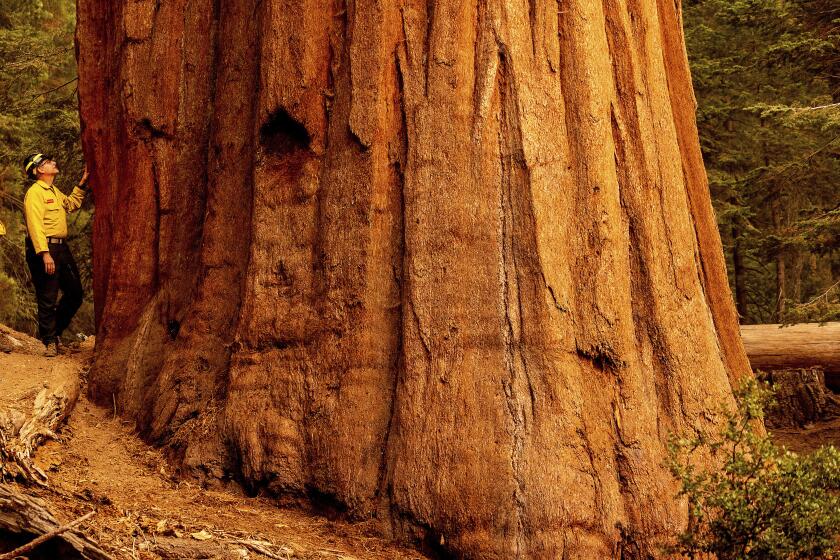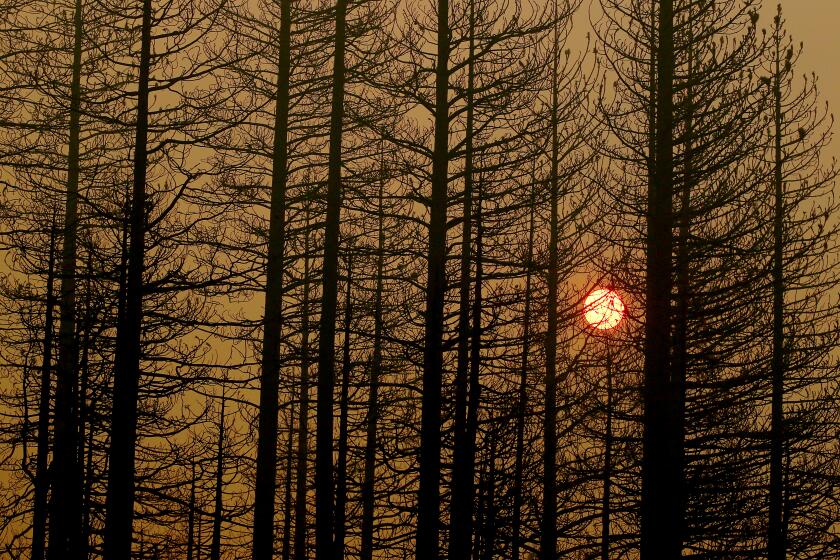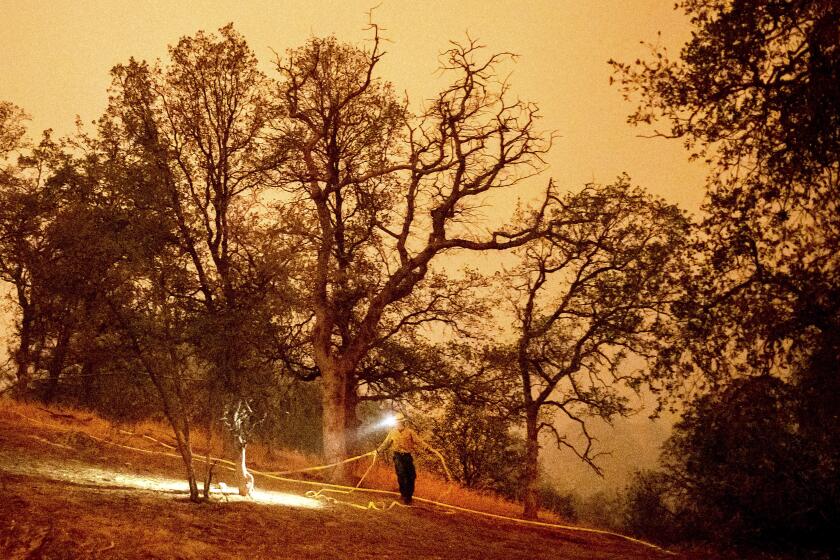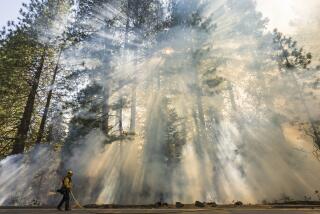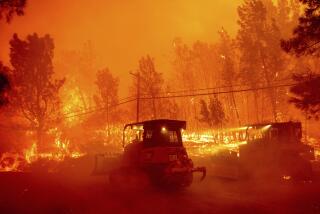Four Guardsmen safe, but giant sequoia burns; cabins threatened
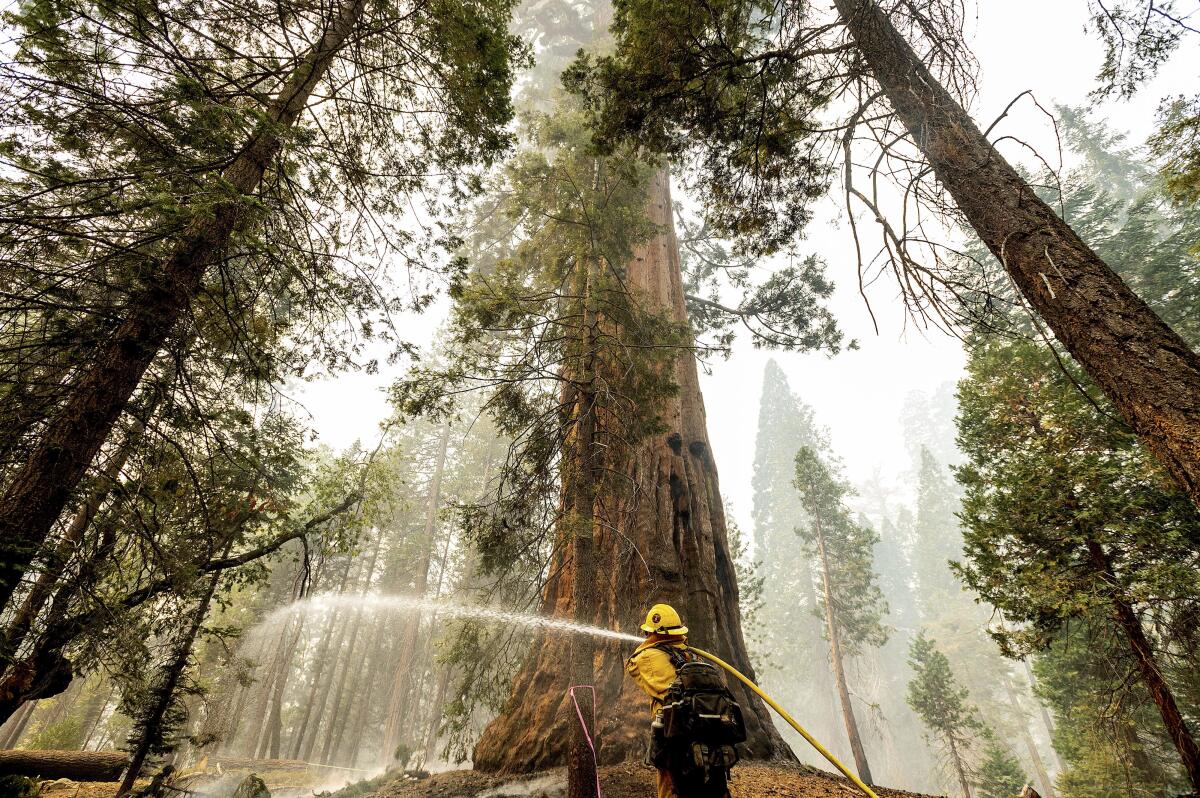
As the Windy fire torched the top of at least one towering tree in the Sequoia National Forest, a new threat emerged Tuesday when the nearby KNP Complex moved closer to a collection of century-old cabins.
For days, firefighters have been locked in an unusual battle to defend California’s giant sequoias, sometimes fighting fire with fire. By Tuesday, the General Sherman tree, the largest tree in the world, was relatively unscathed by the KNP Complex, as were the Four Guardsmen trees that stand at attention at the entrance to the Giant Forest, officials said.
But other areas have not been so lucky. The Windy fire, which is burning to the south of the KNP, moved into Long Meadow Grove, home of the famed Trail of 100 Giants, and at least one sequoia known as the Bench Tree was significantly damaged. More remote stands such as the Peyrone Grove also have been “completely surrounded” by wildfire, officials said, though it was too soon to tell whether any trees had been killed.
Meanwhile, firefighters on Tuesday were turning their attention toward the historic communities of Cabin Cove, Silver City and Mineral King, where some of the hundred-year-old cabins were about three miles from the edge of the KNP Complex. The fire has swelled to 25,142 acres and remains uncontained.
Crews have used controlled burns, protective foil and other protective measures to guard Sequoia National Park.
“We have a structure group up in Mineral King that is either wrapping structures, enhancing their defensible space or setting up sprinklers around some of these cabins just in case,” KNP Complex incident spokesman Mark Garrett said.
It might be a familiar image for those who saw the General Sherman tree wrapped in foil at the end of last week. Officials and cabin owners hope the fire-resistant aluminum that helped shield the giant trees from heat and embers will now help protect the historic homes.
“We’re all concerned,” said John Crowe, president of the Mineral King District Assn., who was born in his family’s cabin in Cabin Cove. “We’re kind of waiting each day to see what’s happening.”
The area is home to more than 65 cabins that sit on Forest Service land, some of which date to the 1870s, Crowe said. Though they cannot be occupied year-round, many of the old mining cabins have been in the same families for generations.
Caring for them is a “labor of love,” Crowe said, and he and others in the tightknit community are anxiously awaiting updates from afar after evacuating last week. Most of the cabins are made of wood, and can be altered only with approval from the Park Service and, in many cases, the California Historical Society.
“It’s a historic location that we’d like to preserve, not only for ourselves, but for posterity, for the public,” Crowe added.
Garrett, the fire incident spokesman, explained that the Mineral King area sits at the entrance to the high country, so for the fire to reach the cabins, it would have to make a significant run uphill to an elevation of 7,800 feet. A rocky rim known as Paradise Ridge also stands between the flame-front and the homes, and already has helped stop the forward progression of some fire, along with bulldozer lines laid by fire crews.
But fire behavior is increasingly unpredictable as California experiences a new breed of climate change-fueled wildfires that are hotter, faster and more intense than ever before. A shift of wind, an airborne ember or a crack of lightning can quickly change the trajectory of a fire once believed to be under control.
“The area is highly combustible because there are so many dead and dying trees, and there’s so much undergrowth that’s built up over the years,” Crowe said. “It’s so dry, and fire can reach miles in a short time depending on how the wind blows.”
What’s more, experts have noted that California’s wildfires are climbing to ever-higher elevations thanks to the increasing heat and dryness plaguing the state’s landscape — transforming areas that previously were too wet to burn into tinder-box terrains.
The days to come are expected to bring more heat to the fire area, Garrett said, with a warming trend slated to deliver temperatures in the high 90s for the rest of the week.
Climate warming has exposed an additional 31,400 square miles of forests to fire at higher elevations, where flames are scorching terrains that previously were too wet to burn.
Those same factors are contributing to the challenging firefighting conditions of the Windy fire, which is burning on the Tule River Reservation and Giant Sequoia National Monument. At 27,183 acres, the Windy fire is even larger than the KNP Complex, although it is 5% contained.
Officials confirmed that flames from the Windy had reached the top of the Bench Tree, so named for the natural bench-like formation at its base. The sequoia is situated along the Trail of 100 Giants, home to some trees as tall as 220 feet, although officials could not immediately confirm the size of the Bench Tree.
Windy fire incident spokesman Steve Rasmussen said helicopters had conducted as many as 14 water drops directly on the tree to extinguish the flames burning atop its crown.
Sequoias are some of the most fire-adapted trees on the planet, and their thick bark helps armor them against flames. But experts grow concerned when fire reaches their crowns, as it did in last year’s Castle fire, which wiped out an estimated 10% to 14% of the world’s sequoia population.
The 8,940-acre KNP Complex fire is within striking distance of Sequoia National Park’s Giant Forest, home to the largest tree on Earth, officials said.
Rasmussen said it was not yet clear whether the fire scaled the tree from the ground up, or whether an ember spotted upward and singed only the top. Experts will assess the tree to determine whether it has suffered permanent damage as soon as it is safe to do so.
But even with significant resources dedicated to defending the sequoias, the Windy fire, like the KNP Complex, still poses a threat. Crews on Tuesday were employing the same techniques they use for structure defense to protect the giants in Long Meadow Grove, including clearing away vegetation from their bases, extinguishing flames as they arrive and dropping water and retardant from above, officials said.
Though strong winds have died down, high temperatures and low humidity levels continue to blanket the fire area and nearby communities such as Camp Nelson, Ponderosa, Peppermint, Johnsondale and Camp Whitsett, Rasmussen said.
“It’s still very dry fuels, very dry air mass and hot,” he said. “So everything is still very readily ignitable.”
More to Read
Sign up for Essential California
The most important California stories and recommendations in your inbox every morning.
You may occasionally receive promotional content from the Los Angeles Times.
